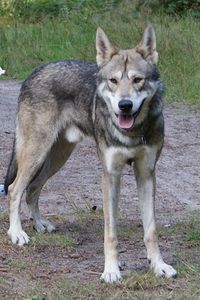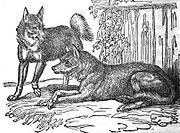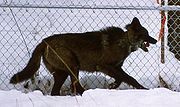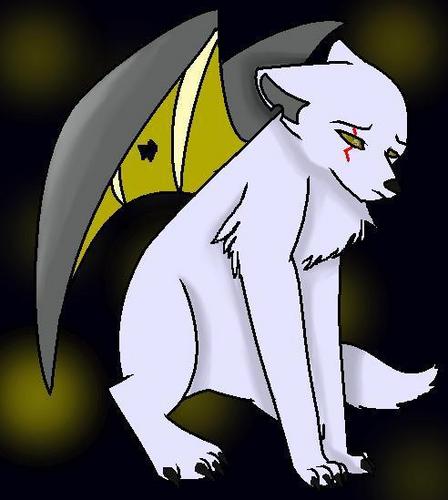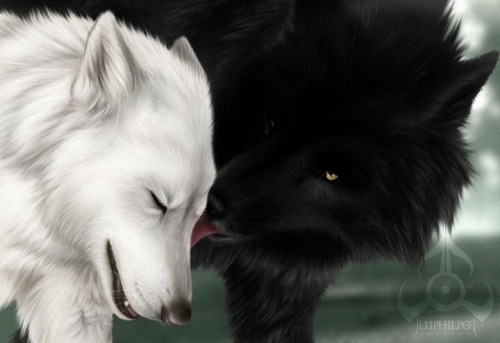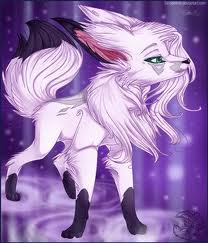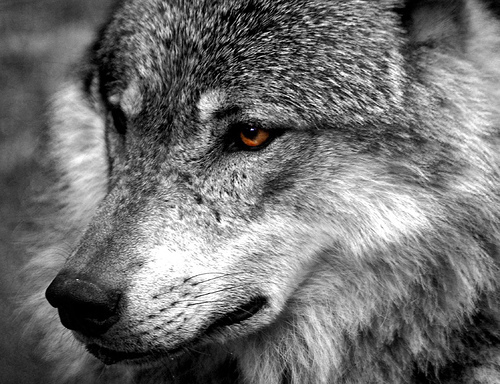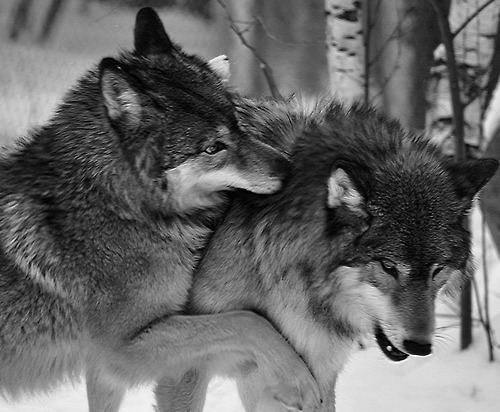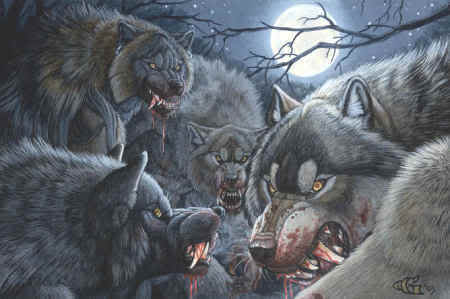A wolf-dog hybrid (also called a wolf hybrid or wolfdog) is a canid hybrid resulting from the mating of a wolf (Canis lupus lupus) and a dog (Canis lupus familiaris). The term "wolfdog" is preferred by most wolfdog proponents and breeders since the domestic dog was recently taxonomically recategorized as a subspecies of wolf. Professional organizations such as the American Veterinary Medical Association and government agencies such as the United States Department of Agriculture refer to the animals as wolf-dog hybrids. Rescue organizations consider any animal with wolf heritage within the last five generations to be a wolfdog, including some established wolfdog breeds.
In 1998, the USDA estimated an approximate population of 300,000 wolfdogs in the United States (the highest of any country world-wide), with some other sources giving a population possibly as high as 500,000. In first generation hybrids, gray wolves are most often crossed with wolf-like dogs (such as German Shepherd Dogs, Siberian Huskies, and Alaskan Malamutes) for an appearance most appealing to owners desiring to own an exotic pet. Since wolf hybrids are genetic mixtures of wolves and dogs, their physical and behavioral characteristics cannot be predicted with any certainty.
History
Domestication
Wolf-dog hybrids, as illustrated in The Menageries: Quadrupeds Described and Drawn from Living Subjects by W. Ogilby, 1829Evidence for prehistoric domesticated wolfdogs in the Americas dates back at least 10,000 years while fossil evidence in Europe points to their use in hunting mammoths.
The first record of a wolf and dog breeding in Great Britain comes from the year 1766 when what is thought that a male wolf had mated with a Pomeranian bitch, which resulted in a litter of nine pups. Wolfdogs were occasionally purchased by English noblemen, who viewed them as a scientific curiosity. Wolfdogs were popular exhibits in British menageries and zoos. In terms of intentional breeding efforts, the first documented wolfdog breed, the Saarlooswolfhond, did not begin to be developed until the 1920s. Hybrids were used as experimental attack dogs in South Africa under apartheid. Genetic research from the Stanford University School of Medicine and the University of California, Los Angeles revealed that wolves with black pelts owe their distinctive coloration to a mutation that first arose in domestic dogs.
Breed-specific legislation
The wolfdog hybrid has been the center of much controversy for much of its history, and most breed-specific legislation is either the result of the animal's perceived danger or a categorization as protected native wildlife. The Humane Society of the United States, the RSPCA, Ottawa Humane Society, the Dogs Trust and the Wolf Specialist Group of the IUCN Species Survival Commission consider wolfdogs to be wild animals and therefore unsuitable as pets, and support an international ban on the private possession, breeding and sales of wolf-dog hybrids. According to the National Wolfdog Alliance, 40 U.S. states effectively forbid the ownership, breeding and importation of wolfdogs, while others impose some form of regulation upon ownership. Most European nations, as well as many U.S. states and municipalities, also either outlaw the animal entirely or put restrictions on ownership.
Wolf-dog hybrids in the wild
Hybridization in the wild usually occurs near human habitations where wolf density is low and dogs are common. However, there were several reported cases of wolf-dogs in areas with normal wolf densities in the former Soviet Union. Wild wolf-dogs were occasionally hunted by European aristocracy, and were termed lycisca to distinguish them from common wolves. Noted historic cases (such as the Beast of Gévaudan) of large wolves that were abnormally aggressive toward humans, may be attributable to wolf-dog mating. In Europe, unintentional matings of dogs and wild wolves have been confirmed in some populations through genetic testing. As the survival of some Continental European wolf packs is severely threatened, scientists fear that the creation of wolf-dog hybrid populations in the wild is a threat to the continued existence of European wolf populations. However, extensive wolf-dog hybridization is not supported by morphological evidence, and analyses of mtDNA sequences have revealed that such matings are rare. However, since mtDNA is mainly maternally inherited and most cases of hybridization in the wild seem to occur between a female wolf and a male domestic dog,[citation needed] these results may not be reliable. In 1997, during the Mexican Wolf Arizona Reintroduction, controversy arose when a captive pack at Carlsbad designated for release was found by Roy McBride, who had captured many wolves for the recovery programme in the 1970s, to be largely composed of wolf-dogs. Though staff initially argued that the animal's odd appearance was due to captivity and diet, it was later decided to euthanise them.
Description
Genetic research has shown that wolves with black pelts owe their colouration to a mutation that first arose in domestic dogsThe physical characteristics of an animal created by breeding a wolf to a dog are not predictable, similar to that of mixed-breed dogs. Genetic research shows that wolf and dog populations initially diverged approximately 14,000 years ago and have interbred only occasionally since; thus imbuing the dissimilarity between dogs and wolves in behavior and appearance. In many cases the resulting adult wolfdog may be larger than either of its parents due to the genetic phenomenon of heterosis (commonly known as hybrid vigor). Breeding experiments in Germany with poodles and wolves, and later on with the resulting wolf-dogs showed unrestricted fertility, mating via free choice and no significant problems of communication (even after a few generations). The offspring of poodles with either coyotes and jackals however all showed a decrease in fertility, significant communication problems as well as an increase of genetic diseases after three generations of interbreeding between the hybrids. The researchers therefore concluded that domestic dogs and wolves are the same species.
Hybrids display a wide variety of appearances, ranging from a resemblance to dogs without wolf blood to animals that are often mistaken for full-blooded wolves. A lengthy study by DEFRA and the RSPCA found several examples of misrepresentation by breeders and indeterminate levels of actual wolf pedigree in many animals sold as wolfdogs. The report noted that uneducated citizens misidentify dogs with wolf-like appearance as wolfdogs. Wolf-dogs tend to have somewhat smaller heads than pure wolves, with larger, pointier ears which lack the dense fur commonly seen in those of wolves. Fur markings also tend to be very distinctive and not well blended. Black coloured hybrids tend to retain black pigment longer as they age, compared to black wolves. In some cases, the presence of dewclaws is considered a useful, but not absolute indicator of dog gene contamination in wild wolves. Dewclaws are the vestigial fifth toes of the hind legs common in domestic dogs but thought absent from pure wolves, which only have four hind toes. Observations on wild wolf hybrids in the former Soviet Union indicate that wolf hybrids in a wild state may form larger packs than pure wolves, and have greater endurance when chasing prey. High content hybrids typically have longer canine teeth than dogs of comparable size, with some officers in the South African Defence Force commenting that the animals are capable of biting through the toughest padding "like a knife through butter". Their sense of smell apparently rivals that of most established scenthounds. Tests undertaken in the Perm Institute of Interior Forces in Russia demonstrated that high content hybrids took 15–20 seconds to track down a target in training sessions, whereas ordinary police dogs took 3–4 minutes.
Health
Wolf-dog hybrids are generally said to be naturally healthy animals, and are affected by fewer inherited diseases than most breeds of dog. Wolfdogs are usually healthier than either parent due to heterosis. Some of the established breeds of wolfdog that exist today were bred specifically to improve the health and vigor of working dogs.
There is some controversy over the effectiveness of the standard dog/cat rabies vaccine on a wolfdog. The USDA has not to date approved any rabies vaccine for use in wolf-dog hybrids, though they do recommend an extra-label use of the vaccine. Wolfdog owners and breeders purport that the lack of official approval is a political move to prevent condoning wolfdog ownership.
Temperament and behavior
Wolf-dog hybrids are a mixture of genetic traits, which results in less predictable behavior patterns compared to either the wolf or dog. This is not to say that the behavior of any specific hybrid is erratic. It would, however, be unlikely that someone unfamiliar with an individual animal would be able to predict that animal's behavior with reasonable certainty. The adult behavior of hybrid pups also cannot be predicted with comparable certainty to dog pups, even in third-generation pups produced by wolfdog matings with dogs or from the behavior of the parent animals. Thus, though the behavior of a single individual wolf hybrid may be predictable, the behavior of the type as a whole is not. The majority of high wolf-content hybrids are very curious and are generally more destructive than dogs.
Aggression
According to the CDC and the Humane Society of the United States, the wolfdog ranks sixth in the number of dog attack fatalities in the U.S., with 14 hybrid-related fatalities between 1979 and 1998 in the United States. In 2000, DEFRA and the Royal Society for the Prevention of Cruelty to Animals released a lengthy study that attributed much of the reported aggressiveness of wolfdogs to the characteristics of the breeds of dogs the wolves are bred with. With both wolves' and dogs' social habits revolving around a pack structure, some wolfdogs may not show the dog's natural acceptance of humans as the dominant pack members, possibly resulting in physical confrontations. Some purport that attacks may not even be caused by typical behavior patterns of aggression and dominance present in either parent species, but instead may be related to predatory instincts, as the majority of attacks involve small children. Between 1981 and 1999, there have been 38 severe attacks and 13 fatalities caused by wolf hybrids in North America, with all victims being children.
Although not all wolfdogs will be aggressive, as some have shown to be gentler and easier to handle than others, the probability of aggressive behaviour from a hybrid varies from animal to animal, depending on whether or not the animal has a high prey drive, and peaks at the onset of sexual maturity, when the animal attempts to achieve dominance over other pack members. This aggression tends to peak during the winter months when hormones run high. Attacks may also be spurred by people becoming suddenly and conspicuously vulnerable due to either injury, disease or fear. Some half-hearted test attacks may be misinterpreted as play, and result in the owner failing to discourage such behaviour. An officer in the South African Defence Force once commented that it was very difficult to dissuade wolf hybrids from pressing an assault once an attack was initiated.
Trainability
Most wolf and wolfdog rescue organizations maintain wolfdogs retain many of the traits and requirements of their wild relatives and therefore may be inappropriate as domestic pets. The view that aggressive characteristics are inherently a part of wolfdog temperament has been contested in recent years by wolfdog breeders and other advocates of wolfdogs as pets. Proponents of wolfdogs as pets say that the animals are naturally timid and fearful of humans, but that with proper training and responsible ownership wolfdogs can become good pets. Even in cases of wolfdogs displaying consistently dog-like behavior, they still often retain some wolf-like behavior such as howling, digging, chewing up household items such as furniture, and, to varying degrees, display considerable difficulty in housebreaking.
Breeds
Today, at least seven breeds of dog exist which acknowledge a significant amount of recent wolf-dog hybridization in their creation. Four breeds were the result of intentional crosses with German Shepherd Dogs, and have distinguishing characteristics of appearance that may reflect the varying subspecies of wolf that contributed to their foundation stock. Other, more unusual crosses have occurred; recent experiments in Germany were conducted in the crossing of wolves and poodles. The intention in creating the breeds was manifold; ranging from the desire for a recognizable companion wolfdog, to military working dogs.
The eldest breed, the Saarlooswolfhond, traces its origins to the efforts of a Dutch breeder in 1921. This first attempt at sustained wolf-dog crossing was to improve Shepherd breeding stock and prevent canine distemper. Though this effort failed, today the FCI and the Dutch Kennel Club both recognize the breed.
In the 1950s, the Kunming Wolf-dog was created, as a working military dog.
In the 1950s the Czechoslovakian Wolfdog was also created to work on border patrol in the countries now known as Slovakia and the Czech Republic. It is recognized by the Foundation Stock Service of the American Kennel Club AKC, the United Kennel Club UKC, and the FCI, and today is used in agility, obedience, search and rescue, police work, therapy work, and herding in Europe and the United States.
The Lupo Italiano has also been accepted into the Italian Kennel Club.
In 1998, the USDA estimated an approximate population of 300,000 wolfdogs in the United States (the highest of any country world-wide), with some other sources giving a population possibly as high as 500,000. In first generation hybrids, gray wolves are most often crossed with wolf-like dogs (such as German Shepherd Dogs, Siberian Huskies, and Alaskan Malamutes) for an appearance most appealing to owners desiring to own an exotic pet. Since wolf hybrids are genetic mixtures of wolves and dogs, their physical and behavioral characteristics cannot be predicted with any certainty.
History
Domestication
Wolf-dog hybrids, as illustrated in The Menageries: Quadrupeds Described and Drawn from Living Subjects by W. Ogilby, 1829Evidence for prehistoric domesticated wolfdogs in the Americas dates back at least 10,000 years while fossil evidence in Europe points to their use in hunting mammoths.
The first record of a wolf and dog breeding in Great Britain comes from the year 1766 when what is thought that a male wolf had mated with a Pomeranian bitch, which resulted in a litter of nine pups. Wolfdogs were occasionally purchased by English noblemen, who viewed them as a scientific curiosity. Wolfdogs were popular exhibits in British menageries and zoos. In terms of intentional breeding efforts, the first documented wolfdog breed, the Saarlooswolfhond, did not begin to be developed until the 1920s. Hybrids were used as experimental attack dogs in South Africa under apartheid. Genetic research from the Stanford University School of Medicine and the University of California, Los Angeles revealed that wolves with black pelts owe their distinctive coloration to a mutation that first arose in domestic dogs.
Breed-specific legislation
The wolfdog hybrid has been the center of much controversy for much of its history, and most breed-specific legislation is either the result of the animal's perceived danger or a categorization as protected native wildlife. The Humane Society of the United States, the RSPCA, Ottawa Humane Society, the Dogs Trust and the Wolf Specialist Group of the IUCN Species Survival Commission consider wolfdogs to be wild animals and therefore unsuitable as pets, and support an international ban on the private possession, breeding and sales of wolf-dog hybrids. According to the National Wolfdog Alliance, 40 U.S. states effectively forbid the ownership, breeding and importation of wolfdogs, while others impose some form of regulation upon ownership. Most European nations, as well as many U.S. states and municipalities, also either outlaw the animal entirely or put restrictions on ownership.
Wolf-dog hybrids in the wild
Hybridization in the wild usually occurs near human habitations where wolf density is low and dogs are common. However, there were several reported cases of wolf-dogs in areas with normal wolf densities in the former Soviet Union. Wild wolf-dogs were occasionally hunted by European aristocracy, and were termed lycisca to distinguish them from common wolves. Noted historic cases (such as the Beast of Gévaudan) of large wolves that were abnormally aggressive toward humans, may be attributable to wolf-dog mating. In Europe, unintentional matings of dogs and wild wolves have been confirmed in some populations through genetic testing. As the survival of some Continental European wolf packs is severely threatened, scientists fear that the creation of wolf-dog hybrid populations in the wild is a threat to the continued existence of European wolf populations. However, extensive wolf-dog hybridization is not supported by morphological evidence, and analyses of mtDNA sequences have revealed that such matings are rare. However, since mtDNA is mainly maternally inherited and most cases of hybridization in the wild seem to occur between a female wolf and a male domestic dog,[citation needed] these results may not be reliable. In 1997, during the Mexican Wolf Arizona Reintroduction, controversy arose when a captive pack at Carlsbad designated for release was found by Roy McBride, who had captured many wolves for the recovery programme in the 1970s, to be largely composed of wolf-dogs. Though staff initially argued that the animal's odd appearance was due to captivity and diet, it was later decided to euthanise them.
Description
Genetic research has shown that wolves with black pelts owe their colouration to a mutation that first arose in domestic dogsThe physical characteristics of an animal created by breeding a wolf to a dog are not predictable, similar to that of mixed-breed dogs. Genetic research shows that wolf and dog populations initially diverged approximately 14,000 years ago and have interbred only occasionally since; thus imbuing the dissimilarity between dogs and wolves in behavior and appearance. In many cases the resulting adult wolfdog may be larger than either of its parents due to the genetic phenomenon of heterosis (commonly known as hybrid vigor). Breeding experiments in Germany with poodles and wolves, and later on with the resulting wolf-dogs showed unrestricted fertility, mating via free choice and no significant problems of communication (even after a few generations). The offspring of poodles with either coyotes and jackals however all showed a decrease in fertility, significant communication problems as well as an increase of genetic diseases after three generations of interbreeding between the hybrids. The researchers therefore concluded that domestic dogs and wolves are the same species.
Hybrids display a wide variety of appearances, ranging from a resemblance to dogs without wolf blood to animals that are often mistaken for full-blooded wolves. A lengthy study by DEFRA and the RSPCA found several examples of misrepresentation by breeders and indeterminate levels of actual wolf pedigree in many animals sold as wolfdogs. The report noted that uneducated citizens misidentify dogs with wolf-like appearance as wolfdogs. Wolf-dogs tend to have somewhat smaller heads than pure wolves, with larger, pointier ears which lack the dense fur commonly seen in those of wolves. Fur markings also tend to be very distinctive and not well blended. Black coloured hybrids tend to retain black pigment longer as they age, compared to black wolves. In some cases, the presence of dewclaws is considered a useful, but not absolute indicator of dog gene contamination in wild wolves. Dewclaws are the vestigial fifth toes of the hind legs common in domestic dogs but thought absent from pure wolves, which only have four hind toes. Observations on wild wolf hybrids in the former Soviet Union indicate that wolf hybrids in a wild state may form larger packs than pure wolves, and have greater endurance when chasing prey. High content hybrids typically have longer canine teeth than dogs of comparable size, with some officers in the South African Defence Force commenting that the animals are capable of biting through the toughest padding "like a knife through butter". Their sense of smell apparently rivals that of most established scenthounds. Tests undertaken in the Perm Institute of Interior Forces in Russia demonstrated that high content hybrids took 15–20 seconds to track down a target in training sessions, whereas ordinary police dogs took 3–4 minutes.
Health
Wolf-dog hybrids are generally said to be naturally healthy animals, and are affected by fewer inherited diseases than most breeds of dog. Wolfdogs are usually healthier than either parent due to heterosis. Some of the established breeds of wolfdog that exist today were bred specifically to improve the health and vigor of working dogs.
There is some controversy over the effectiveness of the standard dog/cat rabies vaccine on a wolfdog. The USDA has not to date approved any rabies vaccine for use in wolf-dog hybrids, though they do recommend an extra-label use of the vaccine. Wolfdog owners and breeders purport that the lack of official approval is a political move to prevent condoning wolfdog ownership.
Temperament and behavior
Wolf-dog hybrids are a mixture of genetic traits, which results in less predictable behavior patterns compared to either the wolf or dog. This is not to say that the behavior of any specific hybrid is erratic. It would, however, be unlikely that someone unfamiliar with an individual animal would be able to predict that animal's behavior with reasonable certainty. The adult behavior of hybrid pups also cannot be predicted with comparable certainty to dog pups, even in third-generation pups produced by wolfdog matings with dogs or from the behavior of the parent animals. Thus, though the behavior of a single individual wolf hybrid may be predictable, the behavior of the type as a whole is not. The majority of high wolf-content hybrids are very curious and are generally more destructive than dogs.
Aggression
According to the CDC and the Humane Society of the United States, the wolfdog ranks sixth in the number of dog attack fatalities in the U.S., with 14 hybrid-related fatalities between 1979 and 1998 in the United States. In 2000, DEFRA and the Royal Society for the Prevention of Cruelty to Animals released a lengthy study that attributed much of the reported aggressiveness of wolfdogs to the characteristics of the breeds of dogs the wolves are bred with. With both wolves' and dogs' social habits revolving around a pack structure, some wolfdogs may not show the dog's natural acceptance of humans as the dominant pack members, possibly resulting in physical confrontations. Some purport that attacks may not even be caused by typical behavior patterns of aggression and dominance present in either parent species, but instead may be related to predatory instincts, as the majority of attacks involve small children. Between 1981 and 1999, there have been 38 severe attacks and 13 fatalities caused by wolf hybrids in North America, with all victims being children.
Although not all wolfdogs will be aggressive, as some have shown to be gentler and easier to handle than others, the probability of aggressive behaviour from a hybrid varies from animal to animal, depending on whether or not the animal has a high prey drive, and peaks at the onset of sexual maturity, when the animal attempts to achieve dominance over other pack members. This aggression tends to peak during the winter months when hormones run high. Attacks may also be spurred by people becoming suddenly and conspicuously vulnerable due to either injury, disease or fear. Some half-hearted test attacks may be misinterpreted as play, and result in the owner failing to discourage such behaviour. An officer in the South African Defence Force once commented that it was very difficult to dissuade wolf hybrids from pressing an assault once an attack was initiated.
Trainability
Most wolf and wolfdog rescue organizations maintain wolfdogs retain many of the traits and requirements of their wild relatives and therefore may be inappropriate as domestic pets. The view that aggressive characteristics are inherently a part of wolfdog temperament has been contested in recent years by wolfdog breeders and other advocates of wolfdogs as pets. Proponents of wolfdogs as pets say that the animals are naturally timid and fearful of humans, but that with proper training and responsible ownership wolfdogs can become good pets. Even in cases of wolfdogs displaying consistently dog-like behavior, they still often retain some wolf-like behavior such as howling, digging, chewing up household items such as furniture, and, to varying degrees, display considerable difficulty in housebreaking.
Breeds
Today, at least seven breeds of dog exist which acknowledge a significant amount of recent wolf-dog hybridization in their creation. Four breeds were the result of intentional crosses with German Shepherd Dogs, and have distinguishing characteristics of appearance that may reflect the varying subspecies of wolf that contributed to their foundation stock. Other, more unusual crosses have occurred; recent experiments in Germany were conducted in the crossing of wolves and poodles. The intention in creating the breeds was manifold; ranging from the desire for a recognizable companion wolfdog, to military working dogs.
The eldest breed, the Saarlooswolfhond, traces its origins to the efforts of a Dutch breeder in 1921. This first attempt at sustained wolf-dog crossing was to improve Shepherd breeding stock and prevent canine distemper. Though this effort failed, today the FCI and the Dutch Kennel Club both recognize the breed.
In the 1950s, the Kunming Wolf-dog was created, as a working military dog.
In the 1950s the Czechoslovakian Wolfdog was also created to work on border patrol in the countries now known as Slovakia and the Czech Republic. It is recognized by the Foundation Stock Service of the American Kennel Club AKC, the United Kennel Club UKC, and the FCI, and today is used in agility, obedience, search and rescue, police work, therapy work, and herding in Europe and the United States.
The Lupo Italiano has also been accepted into the Italian Kennel Club.


